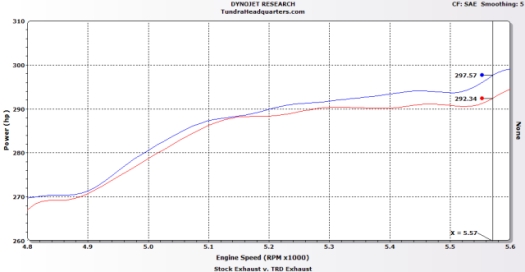 All Entries in the "Toyota Tundra Accessories" Category
All Entries in the "Toyota Tundra Accessories" Category
Toyota Tundra Lift Kit Review: Truxxx 3″ Lift Kit
Lift and leveling kits are some of the most popular accessories for the new Tundra — they improve the look and stance of the truck, allow for bigger tires and wheels, and can even improve ground clearance. We’ve already reviewed the ToyTec 3″ lift kit for the Tundra, now we’re going to review another popular option, the Truxxx Tundra 3″ lift kit.
Based in Tucson, Arizona, Truxxx started out installing after-market parts for truck owners in the Tucson area before becoming a manufacturer. All Truxxx lift kits are made in the USA and come with a lifetime warranty. The spacers are powder-coated steel, and the nuts and bolts are cadmium plated with serrated flange heads and built-in washers. We dislike the use of steel – it’s heavier than aluminum and the powder coating can be chipped, exposing the spacers to the elements…but this is a minor complaint. Overall, the kit is of good quality.
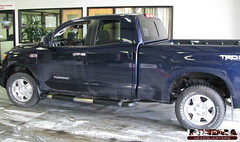 Before.
Before.
 After.
After.
Click photos for a larger view.
The Truxxx kit is designed to raise the front of the Tundra 3? and the rear 1?, thus leveling the truck while also increasing the height about 1?.
Search terms people used to find this page:
- tundraheadquarters
TRD Parts for the Toyota Tundra
Here’s a list of TRD parts available for the 2007 and 2008 Toyota Tundra. We’ve included the suggested retail price as well as what you can expect to pay for each part (prices don’t include install).
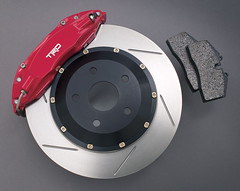 TRD High Performance Brake Kit
TRD High Performance Brake Kit
TRD’s part description: “Provides increased heat capacity for substantially more resistance to brake fade and caliper distortion during multiple stops from high speed. Creates firmer pedal feel due to stronger and more rigid components. Better modulation characteristics under threshold braking…” Our take: Cool. Literally. Keeps brakes cool. If you plan on racing and/or towing like crazy, buy these brakes. You can probably get them for $2500-$2600, but expect to have to order them. The good news is you can put your old rotors and calipers on eBay or Craigslist and get some of your money back.
Fits Tundra 07-08′, Sequoia 08′ with 20″ wheels (or larger, will not fit with 18″ wheels) — Part No. PTR09-34070 — Suggested Retail Price: $2,795
Poor Man’s Alternative: G2 Brake Caliper Paint Red. If you’ve got a few hours and a little bit of talent with a paint can, you can get the look without spending very much. G2 is quality stuff too – stay away from cheap caliper paint kits. They don’t stand up very well under high heat.
G2 Brake Caliper Paint Retails for $38.00, and is available in black, green, purple, and yellow too.
Search terms people used to find this page:
- tundraheadquarters
Toyota Tundra Owners: 7 Gift Ideas
In honor of “black Friday”, we decided to come up with a list of a few items that every Tundra owner might want to have. For best results, print out this list or leave it up on your computer when your significant other walks by. Then, in a loud and clear voice, state “Wow. Sure would be nice to get one of these things as a gift.”
You might also try — “Wow. FREE SHIPPING?! What a deal!!” then make sure they see this ad.
Good. Now that we’ve got that out of the way, here’s our list:
1) Weathertech Extreme-Duty Floor Liner: Winter often makes for a dirty truck, but having a nice set of floor mats that actually collect dirt and moisture will keep the dirt to a minimum. Made thick with a specially ridged underside, WeatherTech Floor Mats provide an impenetrable barrier that’s designed to stay put. WeatherTech’s soft rubber treads offer excellent traction for driving, and the tall outside edge of mats keeps dirt from sliding/sloshing out onto your carpet. They’re easy to clean – just hose ’em off – and they come in 3 universal colors. $114.95 for the front, $81.95 for the back, and free shipping.
 2) Bolt-over Billet Grill: Easy to install (they literally bolt over the factory grill), Carriage Works billet grill covers look great and don’t cost very much. We found a brushed billet grill (pictured) on AutoAnything.com for only $132. You can buy the whole set and have billet for the main grill, top grill (the little sliver above the main grill), and the bumper grills too. If you don’t like the idea of bolting over the factory grill, you can buy a replacement grill for about the same price.
2) Bolt-over Billet Grill: Easy to install (they literally bolt over the factory grill), Carriage Works billet grill covers look great and don’t cost very much. We found a brushed billet grill (pictured) on AutoAnything.com for only $132. You can buy the whole set and have billet for the main grill, top grill (the little sliver above the main grill), and the bumper grills too. If you don’t like the idea of bolting over the factory grill, you can buy a replacement grill for about the same price.
3) K&N Drop-In Air Filter: It’s the least expensive item on the list, but it’s still a great item to have. K&N filters improve gas mileage, performance, and come with a lifetime warranty. Prices range from $38 – $47, depending on engine size.
4) ShurTrax Traction Weight System: For a lot of truck owners, winter means putting sand bags in your truck’s bed. When winter’s over, you’ve got to store them for next year, assuming they haven’t worn out. ShurTrax came up with a new solution – put a big heavy bag of water in the bed. It will add as much as 400lbs of weight to your truck’s bed, boosting traction. When winter’s over, dump the water out and roll up the bag. It’s a slick idea, and it costs $140 for a full-size truck. Also at AutoAnything.com.
 5) TRD Exhaust Tip: From the Toyota Accessory Guide “Enhance the look of your vehicle with this double-walled exhaust tip by Valor Manufacturing. Made from polished 304 stainless steel, which will not rust or corrode.” That pretty much sums it up. The part is listed at $60, but you should be able to get a little bit of a break (try asking for $50). Install is quick and easy. Toyota part # PTS18-34070 for the 5.7L.
5) TRD Exhaust Tip: From the Toyota Accessory Guide “Enhance the look of your vehicle with this double-walled exhaust tip by Valor Manufacturing. Made from polished 304 stainless steel, which will not rust or corrode.” That pretty much sums it up. The part is listed at $60, but you should be able to get a little bit of a break (try asking for $50). Install is quick and easy. Toyota part # PTS18-34070 for the 5.7L.
6) TundraHeadquarters Gear: OK OK — it’s shameless self-promotion — however, if you enjoy this site, why not buy a coffee mug, hat, or t-shirt? Visit the TundraHeadquarters.com store.
7) Volant Cold Air Intake: If you read our Toyota Tundra Volant air intake review, you know we liked this kit. It makes the Tundra sound mean, look mean (at least under the hood), and it might even improve your gas mileage (if you keep your foot out of it). $369.
Search terms people used to find this page:
- tundraheadquarters
Product Review: Volant Cold Air Intake
We found out about the Volant’s new cold air intake for the 5.7L Tundra on TundraTalk.net, a nice forum for Tundra owners. After reading a few positive reviews from forum members, we contacted Volant and asked them if they might be interested in allowing us to review their product. They gladly accepted, and a brand new cold air intake arrived at our door.
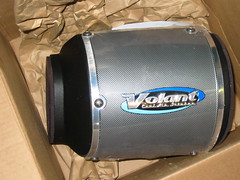 Our first impressions of the Volant intake were positive. Opening the package, we were amazed at just how simple this kit is. There’s the air box, duct, filter, some clamps, a hose connector, and some nuts and bolts. The air box’s chrome surface (see photo) is covered with plastic film to protect the finish as you install the kit — a nice touch. There’s also a brochure and some very rudimentary instructions.
Our first impressions of the Volant intake were positive. Opening the package, we were amazed at just how simple this kit is. There’s the air box, duct, filter, some clamps, a hose connector, and some nuts and bolts. The air box’s chrome surface (see photo) is covered with plastic film to protect the finish as you install the kit — a nice touch. There’s also a brochure and some very rudimentary instructions.
Speaking of instructions, installation is brutally simple. This has definitely got to be one of the highlights of this kit. Simply remove the stock air filter, engine cover, loosen a couple of clamps, unplug a couple of hoses, remove a couple of bolts, and the factory box is out of the truck. Next, you assemble the air box, bolt it into place, and reconnect all the hoses. One complaint we have – and it’s minor – is that the instructions themselves are pretty poor. They tell you how to get the job done, but we think someone should go through them and fill-in a couple of the blanks. The quality of the instructions themselves is also lacking — they look like they were made on an old zerox machine. Finally, the pages of instructions were actually stapled in the wrong order. Like we said, it’s a minor complaint — install is really easy — but the value of the kit might be a little higher if the instructions were higher quality (both in material and clarity).

Volant Air Intake Toyota Tundra Installation video
One of the other problems we have with this kit has to do with Toyota’s engine cover. First of all, in Volant’s defense, the piece of plastic that is supposed to “look like” an engine is stupid. It’s just there so that when a salesman opens the hood of the truck, he doesn’t forget the engine size and the customer can nod appreciatively and say “yes, that’s the 5.7L alright”. Basically, the engine cover is completely useless. Anyways, the problem here (and it’s minor) is that Volant’s air intake takes up some of the space that the engine cover needs to rest in. Volant provides a higher stud for the engine cover to attach to, but it’s not as solid as the factory setup. It’s not a big deal — the engine cover doesn’t do anything, doesn’t support anything, and really doesn’t need to be attached very tightly — but it would be nice if they had a solution that was a little more clever.
Fit and finish on the rest of the kit is excellent – the air box is flush against the fender and completely sealed so that only cool outside air can make it into the engine. [We’ve since been informed that the kit doesn’t completely seal against the fender. There is a small gap. Our tests indicate the gap doesn’t effect performance, but it should be noted.] This is a major selling point for Volant – they have studies that show most air boxes (both OEM and after market) let hot engine gases seep into the air the engine breathes, raising the air’s temperature and thus decreasing performance.
We have to say that the Volant kit looks awesome — it’s much more impressive than the factory air box and it looks a lot nicer than other air intakes we’ve seen. Sure, looks aren’t everything, but who doesn’t like to show off a cool accessory under the hood?
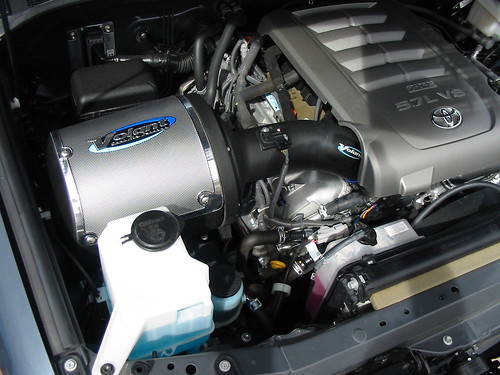
The air filter inside this kit is also a selling point for Volant. Unlike many competing companies, Volant’s PowerCore air filter is not made from cotton gauze. Instead, hundreds of staggered flutes catch 99.95% of the particulates that can damage your motor, and it does so without needing to be oiled periodically. Volant warranties their PowerCore air filters for 4 years or 100k miles, and they offer their filters in sizes that are compatible with air intakes from K&N, AEM, etc. We like the idea of a dry filter (cleaning and re-oiling filters is never fun or interesting), and we are intrigued by Volant’s claim that their filter allows better flow while catching more particulate matter.
So let’s get down to brass tax — how did the intake perform? When we first started the truck, we were amazed at how quite the Volant intake is. Whether sitting at idle or cruising down the highway, we didn’t notice any additional noise from under the hood. However, when you floor the throttle, you can hear the engine sing. Without exaggeration, you just can’t help but smile under full throttle. The sound is so pleasing to the ear, it’s like driving a race car. Very cool. We’d have to say the price of the kit might just be worth the sound alone.

Sounds of the Volant Air Intake for the Toyota Tundra – watch the video to hear the intake in operation.
Additionally, we noticed faster throttle response. Before, our test vehicle hesitated slightly on changes in throttle. With the Volant intake installed, response was almost instantaneous. The truck also felt quicker, both from a dead stop and as we accelerated on the highway. Overall, the kit seemed to make a big difference and it felt very good to drive.As far as horses are concerned, Volant claims the kit will add as much as 21hp to your Tundra’s 5.7L engine. They’ve even got the dyno graph to prove it. Looking closely at Volant’s graph, it looks like the air intake added about 14 hp at 5000 rpm, and nearly 18 hp at 5300 rpm. Our own results basically mirrored that result, but with lower magnitude. We recorded an 8 hp gain at 5000 rpm, and about 10 hp at 5350 rpm. Considering our base truck was making about 287 hp that day, and that the base truck in the Volant test was making nearly 300, we’re thinking that better conditions might have yielded better results (at least for our tests). But, like any cold air intake kit, the manufacturer’s estimates are always a little optimistic. Nonetheless, the difference we felt in power before and after was substantial. We think you can plan on seeing a gain of at least 5-10 hp, with some owners experiencing the full 21 hp Volant reports.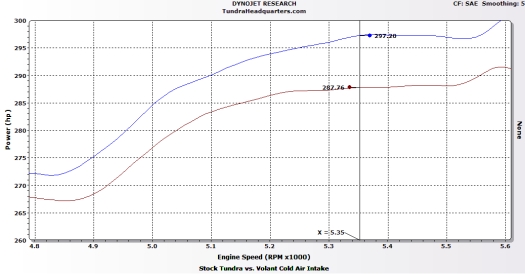
Click for larger view.
All in all, we like the Volant kit. It looks good, sounds good, drives good, and improves performance. We’re extremely confident in telling current Tundra owners that the Volant kit will add power. Like we said in our Tundra air intake guide, the factory air intake is pretty decent. But if you’re looking for a little more power, a more aggressive sounding truck (at least on WOT), or if you want to maximize horsepower gains from other accessories, installing a cold air intake makes sense.
Bottom Line: We really like the look and sound of the Volant kit. Installation is a breeze, and engine performance and throttle response were noticeably improved. We like Volant’s dry air filter, and we’ve read a lot of positive user reviews of the product. We do think the instructions could be a little nicer, and we wish they would have come up with a better way to accommodate the factory engine cover, but overall we will recommend this kit. Be sure to shop around before buying, as we found prices ranging from $360 to more than $500. NOTE: After completing this review, we learned that the kit does not seal against the fender completely. Our tests indicate the kit does add power, and we still like the look and sound, but it must be noted that the kit’s “fit and finish” is not as nice as we first reported. We’re not going to revoke our endorsement because of this issue because the kit does add power — we’ve proven that thru testing — but make sure you get this kit for discount.
Here’s a link to the least expensive Volant Cold Air Intake System we found for the new Tundra.
Search terms people used to find this page:
- tundraheadquarters
Toyota Tundra TRD Dual Exhaust Product Review
A lot of new Tundra owners upgrade their exhaust systems. In fact, it’s probably the most popular accessory that people add to their new trucks. Fortunately (or unfortunately, depending on how you look at it) there are literally HUNDREDS of options. Big names like Borla, Flowmaster, Gibson, and TRD all offer kits for the new Tundra. Of course, if you don’t want to spend that kind of money, or if you like the idea of a custom kit, you can visit your local muffler shop and talk to the experts, and you can even order parts on the internet and install them yourself. Like we said, LOTS of choices.
However a lot of people like to go as “factory” as possible when choosing accessories, and we can certainly understand why. First of all, it’s very easy. If you’ve bought a Tundra, chances are you trust Toyota to make a good product. You can rest assured the TRD exhaust system is a good choice. Secondly a lot of people like factory-backed accessories because they know their won’t be any warranty concerns. Unlike adding an after-market kit, where the directions clearly state “this may violate your factory new vehicle warranty“, you know that a new kit from TRD isn’t going to cause any warranty problems. Finally, there’s just something to be said for having a very “stock” look and feel, even if you have added a bunch of extras.
Whatever your motivation, TRD’s kit is definitely a good choice. To start with, the kit is solid mandrel-bent 409 stainless. 409 stainless is about as good a material as you could ask for, and the mandrel-bent manufacturing process means that any bends in the tubing were done without compromising strength or shape. Since preserving the round shape of the pipe enhances flow, it’s always important to make sure a kit is mandrel bent. Finally, the TRD dual exhaust kit includes double-walled stainless steel tips with an engraved TRD logo. Nice. Looking at a brand new kit, it’s clear that TRD didn’t go cheap.
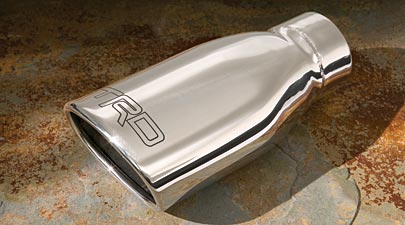
Installation is also about as easy as they come. This is literally a bolt-on kit. The hardest part of the installation is removing the factory system and dealing with those pesky hangers. If you wanted to, you could definitely put this kit on yourself with basic tools. If you wanted to have someone install it for you, it shouldn’t cost more than $100-$150. Most technicians can have this kit on in under two hours.
Like all after market accessories, there is a lot of argument about just how much power this exhaust kit adds. Generally speaking, after market exhausts by themselves offer little in the way of additional power. Typically, the most you’ll see is a 3-5 hp gain with just about any cat-back system. The TRD kit is no exception — our tests show that the TRD Dual Exhaust for the new Tundra added anywhere from 1 to 5 hp. Unfortunately, the increase in horsepower varied quite a bit depending upon RPM. That’s why we like that “3-5hp” number. Check out the dyno performance graph below.
NOTE: Our dyno tests were conducted in 5th gear, and we truncated the RPM range to ensure that the comparison was as accurate as possible. Unfortunately, tests had to be conducted on different days due to time constraints at the dyno shop. We expect a margin of error of +/- 1 hp.
If the horsepower number doesn’t excite you, when you factor in the feeling you get when you step on the gas, you will feel like adding an exhaust is the best money you ever spent. The TRD kit is excellent in terms of sound — little or no additional noise at idle (almost imperceptible at true idle — very impressive), minimal highway “rumble”, and absolutely fantastic sounds at W.O.T. This kit was designed by Toyota to provide the sound that a lot of V8 owners crave while still being quiet enough to preserve the truck’s finer qualities. This perfect balance of sound is easily the TRD kit’s best attribute.
Here’s some video of the truck’s exhaust — make sure your speakers are on for this one:

Check out this Tundra Solutions thread for more TRD exhaust sound clips (props to mxsjw for posting those sound files).
Like we said in our Toyota Tundra exhaust guide, adding an exhaust system alone isn’t going to get you much power. But if you combine the exhaust system with any other upgrades (like a cold air intake), you’ll likely see a multiplying effect for both. As for adding this kit to your truck, we’ll tell you that the list price of the TRD exhaust kit is $1,154. Some other big names offer kits that are very comparable for less money. We’ll also say that your local muffler shop can probably build you a custom system from scratch for even less than any of the kits you’d buy online, and that your local shop will build a system with equal or better performance than any pre-fabricated kit. In other words, the TRD kit is a little too expensive for our tastes, especially when compared to the local muffler shop. However, if you’re only interested in pre-fabricated cat-back systems, the TRD is an excellent choice.
Don’t get us wrong — the TRD kit is quality, backed by Toyota, and as good as anything you’ll find. In fact, we’re willing to bet this kit’s sound aspects are probably the best on the market (but we can’t back that up until we do some more testing). “If you have the means, we highly recommend it.” [Incidentally, we were able to find some discounted pricing for the TRD exhaust. We’re working on getting it for our readers, so stay tuned.]
Bottom Line: The Toyota Tundra TRD Dual Exhaust is excellent, but it’s a little overpriced. If you want to add a quality, factory-backed exhaust system that won’t make your truck sound like a dragster, the TRD product is an excellent choice.
Search terms people used to find this page:
- tundraheadquarters
